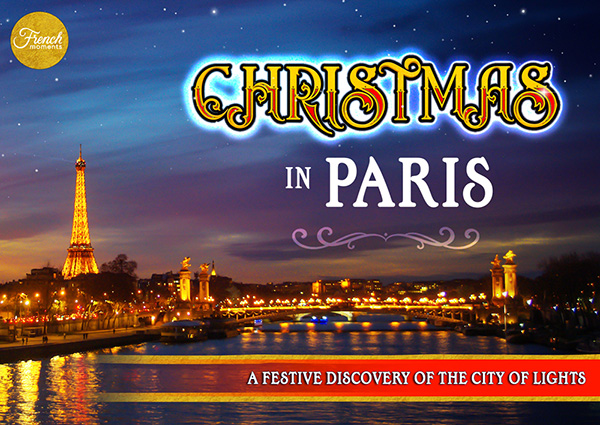Strasbourg cathedral welcomes around 4 million visitors a year, making it the second most visited church in France after Notre-Dame de Paris. As in many churches in Alsace and France, Christmas is a time for nativity scenes, Advent wreaths and other yuletide traditions. The Christmas Nativity Scene in Strasbourg cathedral is no exception. It is one of the largest in France, measuring almost 20 metres in length. Follow the guide!
Strasbourg Cathedral's Nativity Scene
How many of the millions of visitors to Strasbourg's famous Christmas market actually go inside Notre Dame Cathedral? When I was in Strasbourg during the Advent season, it seemed obvious to me that I should go inside the sanctuary. It's in these sacred places that the Christmas story takes on its full meaning. And inside the cathedral, I discovered the great Christmas nativity scene.
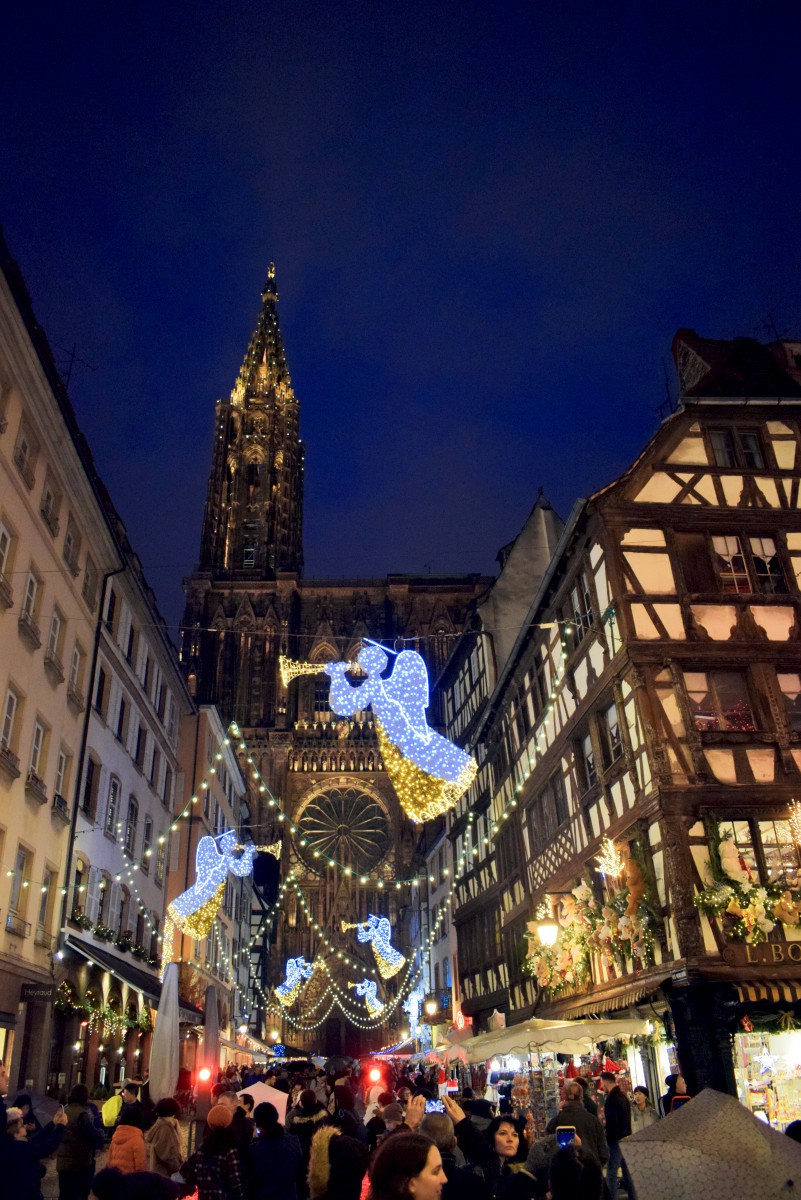
Christmas lights on Rue Mercière and Strasbourg Cathedral © French Moments
The five key moments in the birth of Jesus
The Christmas Nativity scene in Strasbourg Cathedral recounts the five most important stages in the real Christmas story.
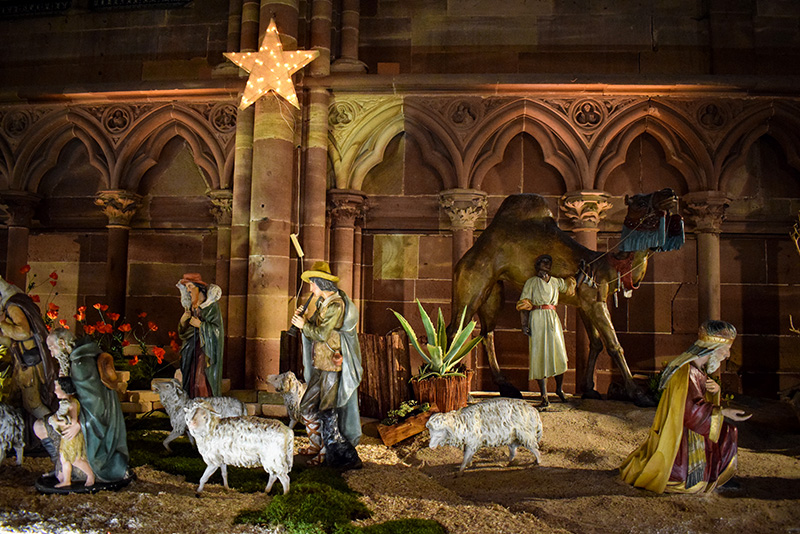
The shepherds and the Star guiding the Magi © French Moments
According to the biblical accounts, the Annunciation marks the moment when the angel Gabriel announced the imminent birth of Jesus to Mary.
The Visitation follows, showing Mary visiting her cousin Elizabeth, herself pregnant by John the Baptist.
The Nativity humbly describes the birth of Jesus in Bethlehem.
The Adoration of the Magi highlights the arrival of the wise men from the East to offer gifts to the newborn child, symbolising the recognition of Jesus as King.
Finally, the Presentation in the Temple depicts the act whereby Mary and Joseph present Jesus in the Temple, by Jewish law, and meet Simeon and Anna, prophets who recognise the holiness of the newborn child.
The large Nativity scene, 18 metres long and 3 metres wide, occupies part of the south aisle of the nave. The five most essential stages in the birth of Jesus are depicted from east to west.
Let's take a closer look at these events in the Nativity scene in Strasbourg Cathedral:
The Annunciation

The Annunciation © French Moments
Bible Passage: Luke 1:26-38 (NKJV)
Excerpt: "Now in the sixth month the angel Gabriel was sent by God to a city of Galilee named Nazareth, to a virgin betrothed to a man whose name was Joseph, of the house of David. (...) Then the angel said to her, 'Do not be afraid, Mary, for you have found favor with God.'"
The Visitation
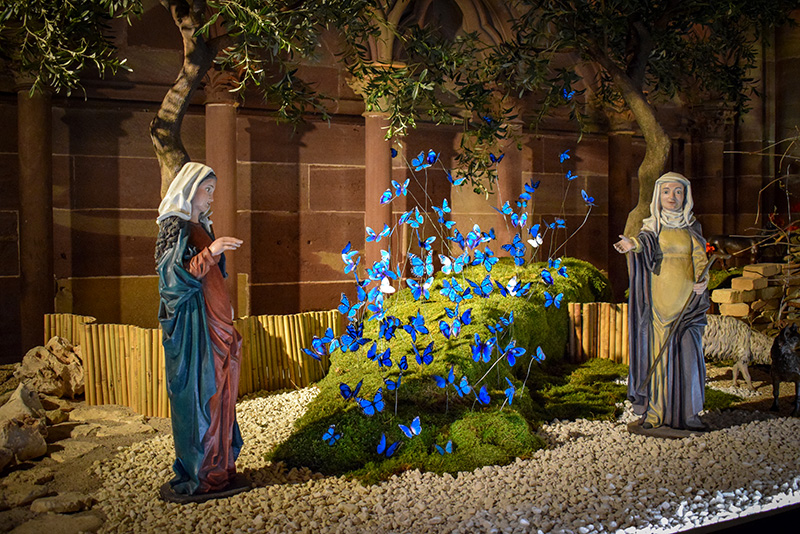
The Visitation © French Moments
Bible Passage: Luke 1:39-56 (NKJV)
Excerpt: "Now Mary arose in those days and went into the hill country with haste, to a city of Judah, and entered the house of Zacharias and greeted Elizabeth."
The Nativity
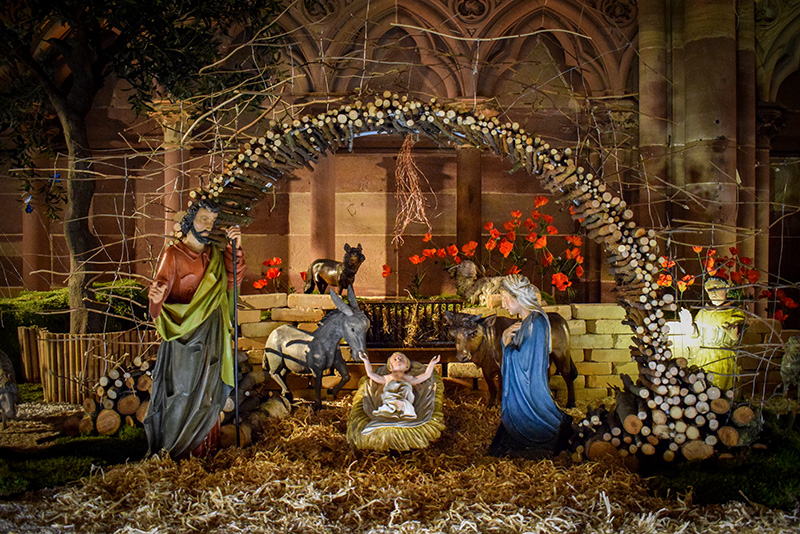
The Nativity © French Moments
Bible Passage: Luke 2:1-20 (NKJV)
Excerpt: "And it came to pass in those days that a decree went out from Caesar Augustus that all the world should be registered. (...) So it was, that while they were there, the days were completed for her to be delivered."
The Adoration of the Magi
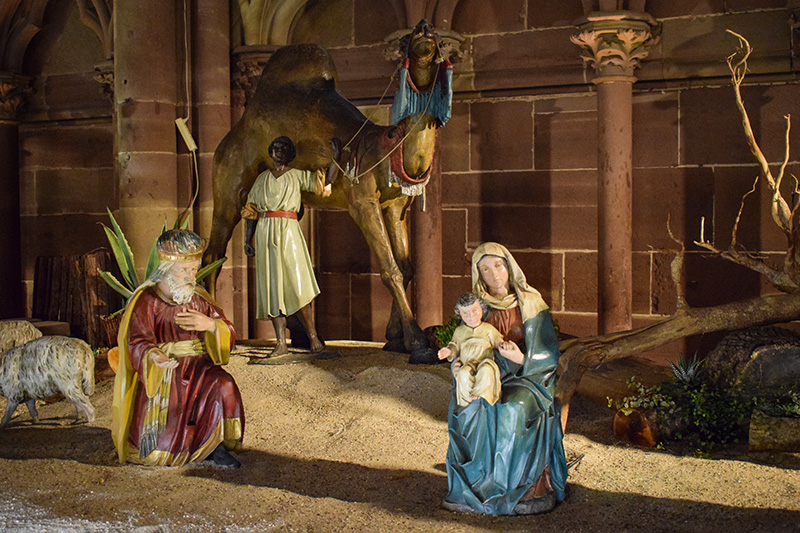
TheAdoration of the Magi © French Moments
Bible Passage: Matthew 2:1-12 (NKJV)
Excerpt: "Now after Jesus was born in Bethlehem of Judea in the days of Herod the king, behold, wise men from the East came to Jerusalem, saying, 'Where is He who has been born King of the Jews?'"
The Presentation in the Temple
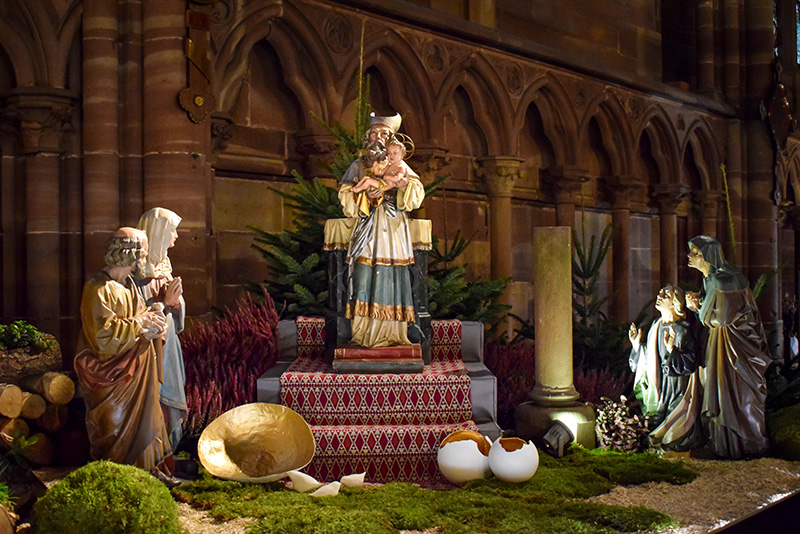
The Presentation in the Temple © French Moments
Bible Passage: Luke 2:22-38 (NKJV)
Excerpt: "Now when the days of her purification according to the law of Moses were completed, they brought Him to Jerusalem to present Him to the Lord."
The history of the Nativity scene in Strasbourg cathedral
The Christmas Nativity scene in Strasbourg Cathedral has a history all its own.
In 1907, Canon Eugène Muller acquired the cot in Oberammergau, a town in Bavaria renowned for its woodcarving craftsmen.
The original Nativity scene was populated by 80cm-high wooden figures and comprised three sections: the Nativity, the Adoration of the Magi and the Presentation in the Temple.
The corresponding backdrop depicted a stable and the houses of the village of Bethlehem set against the mountain. Palm trees were added for an exotic touch.
Unfortunately, the set was destroyed during the Second World War in an air raid.
In the 1990s, two new scenes were added to the monumental Nativity: the Annunciation and the Visitation.
Craftsmen from Oberkirch in neighbouring Baden were called in to create the main actors in these opening scenes, in keeping with the style of the original Nativity scene.
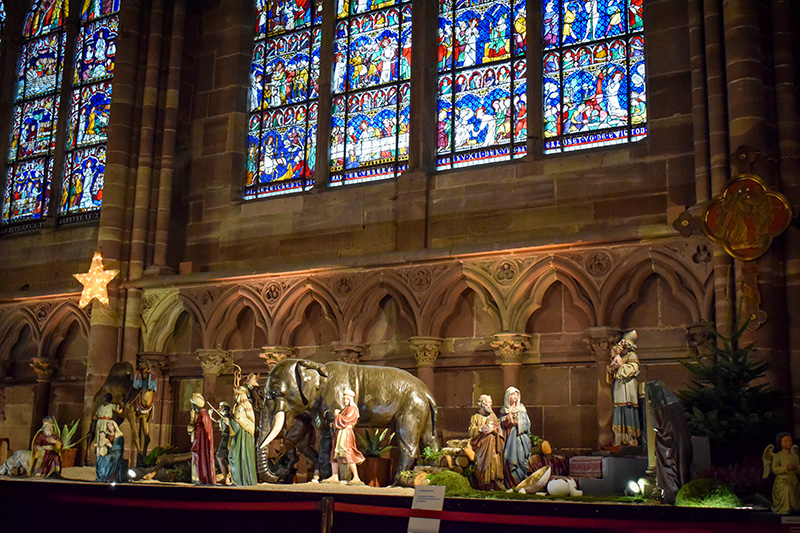
The Christmas Nativity scene at Strasbourg Cathedral © French Moments
A decoration that changes every year
Every year at the end of November, the Christmas Nativity scene in Strasbourg Cathedral welcomes visitors with a new decoration.
In 2016, a beautiful Alsatian house appeared at the entrance to the Nativity . In the house's courtyard, you can see objects that witness rural life in Alsace: corncobs, nut baskets, stoneware pots, an embroidered spinning wheel and tablecloth, kelsch cloth, kugelhopfs, etc.
In 2021, it was made up of fir trees, a tribute to the town of Sélestat. Indeed, it was in this Alsatian town that the municipal archives preserved a document dating from 1521, which mentions for the first time the tradition of the inhabitants cutting down fir trees for Christmas.
The arch that rises above the Nativity scene is a creation of the Œuvre Notre-Dame de Strasbourg. Here too, the décor of the Nativity scene changes every year.
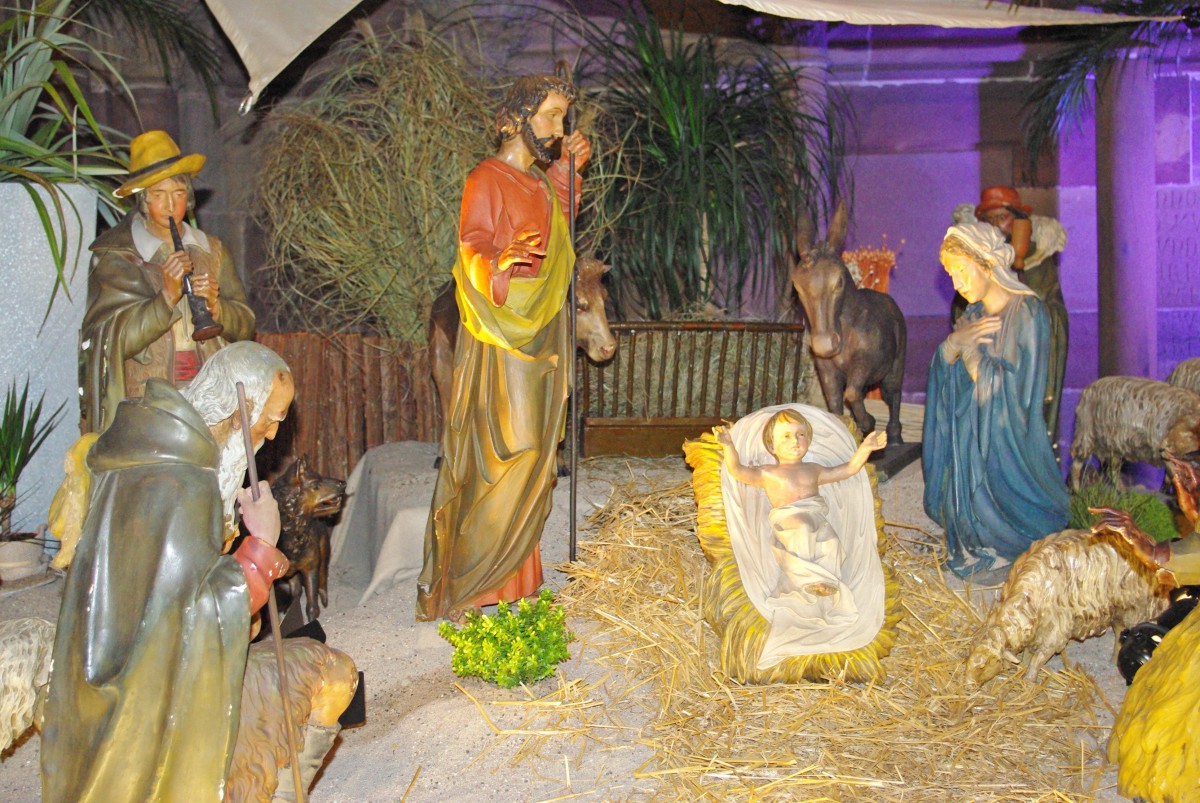
The nativity scene in Strasbourg cathedral in 2012 © French Moments

The arch of the Nativity scene in 2018 © French Moments
The 2021 edition of the Ark is reminiscent of a famous engraving by Martin Schongauer, a late medieval German painter and engraver who was born in Colmar around 1445/1450 and died in Vieux-Brisach in 1491.
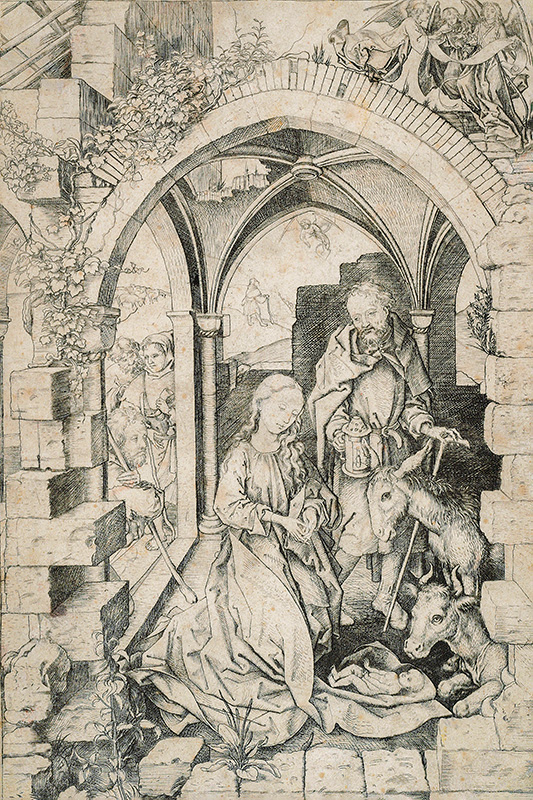
Représentation de la Nativité par Martin Schongauer (vers 1471)
Neapolitan figurines from the 18th century
The large Nativity scene features around forty 18th-century Neapolitan figurines.
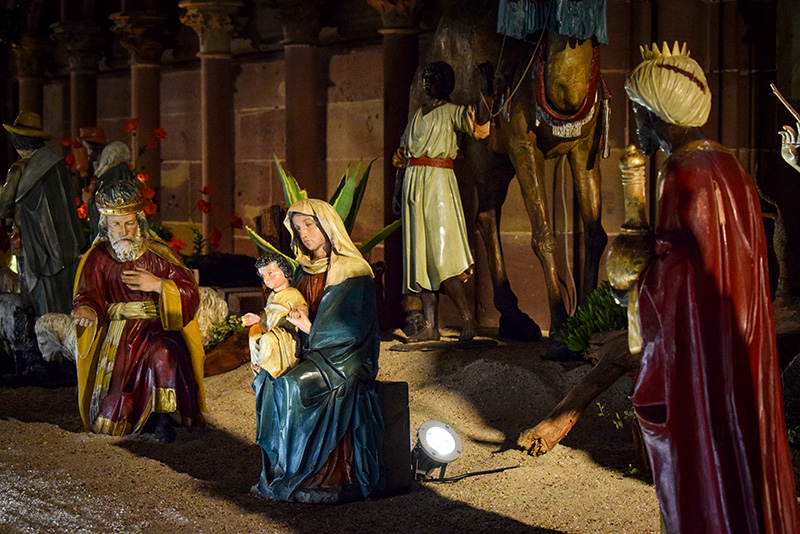
Figurines in Strasbourg's monumental Nativity scene © French Moments
Some Baroque figures were carved in wood before being painted, while others were moulded in terracotta or wax.
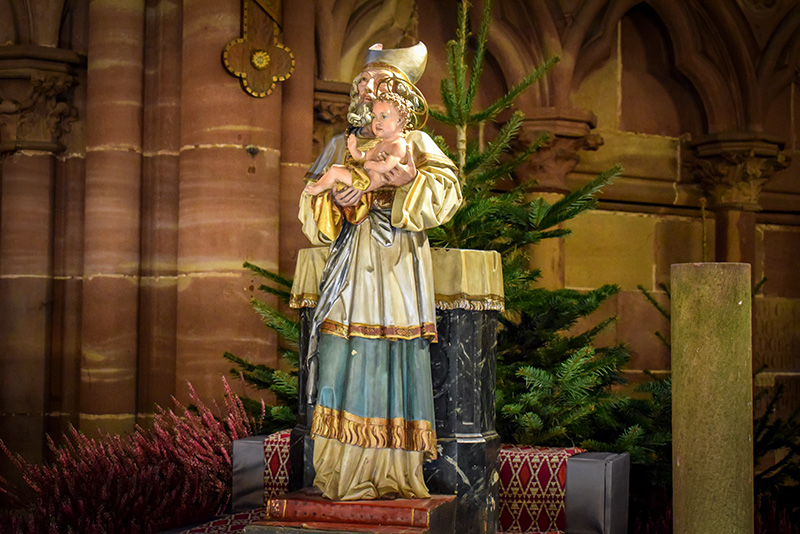
The high priest carrying Jesus in the Temple © French Moments
Almost 80 cm high, they are clothed in cloth.
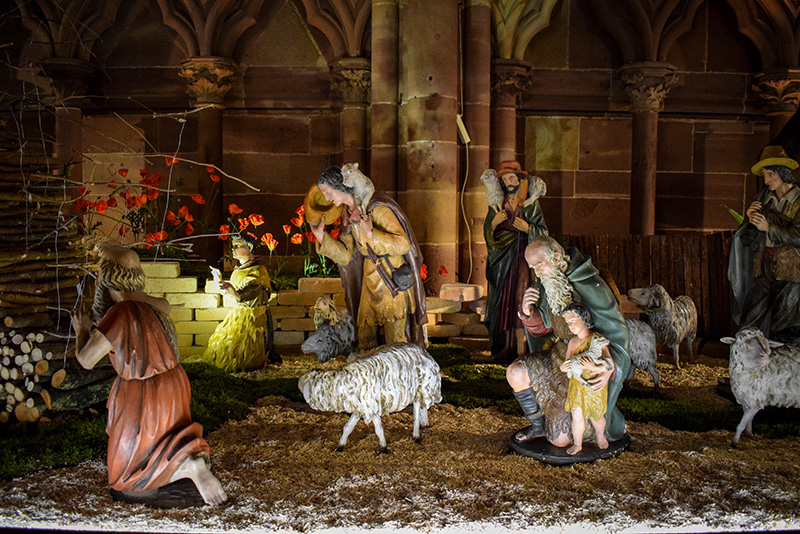
The shepherds © French Moments
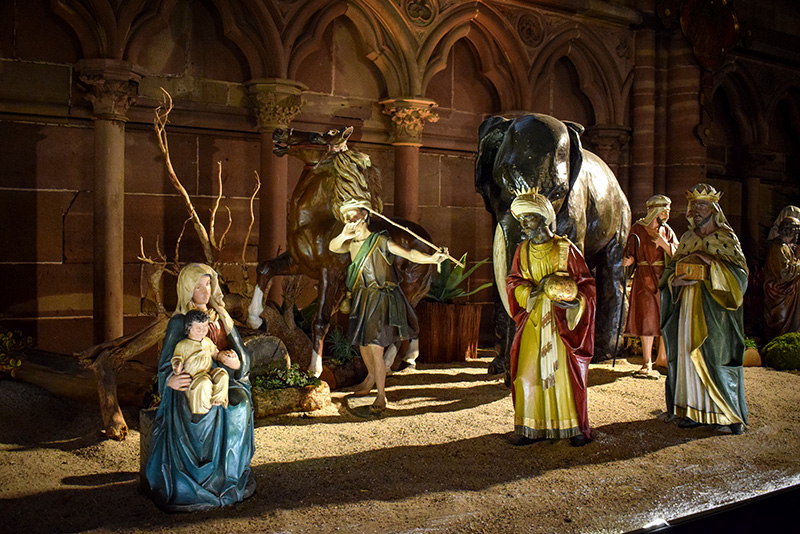
The coming of the Magi © French Moments
The Nativity Scene is also home to animals: sheep, a horse, a grey donkey and an ox, some of which are very impressive. There's a dromedary and... an elephant!
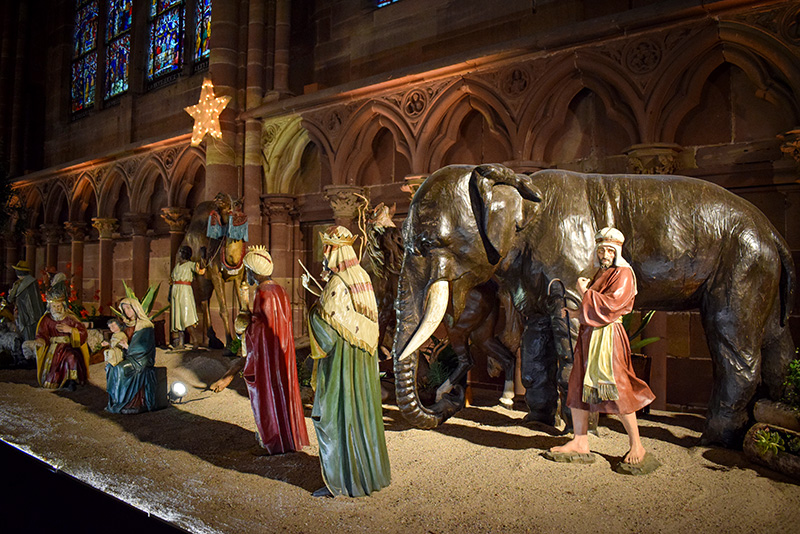
Characters in the Nativity scene © French Moments
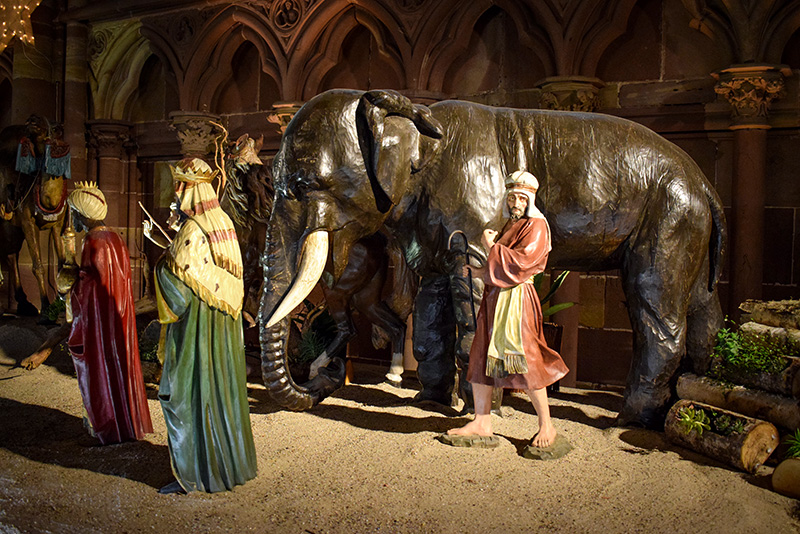
A big elephant in the Strasbourg Nativity scene! © French Moments
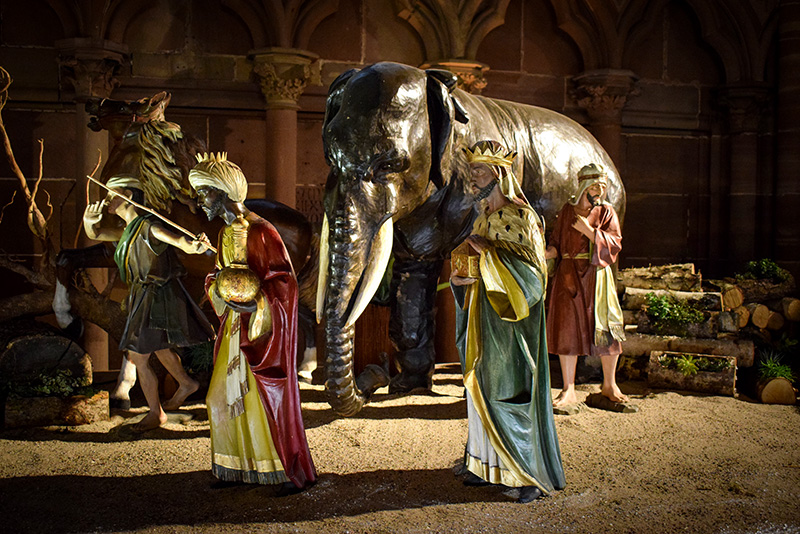
The elephant and the Magi © French Moments
The magnificent pachyderm weighs 140 kg and is therefore kept inside the cathedral for the rest of the year.
Visit Strasbourg Cathedral's Nativity scene
The monumental Nativity scene can be seen from the end of November to 5 February of the following year in the south aisle. However, I advise you to check with official sources for the exact dates, which change from year to year.
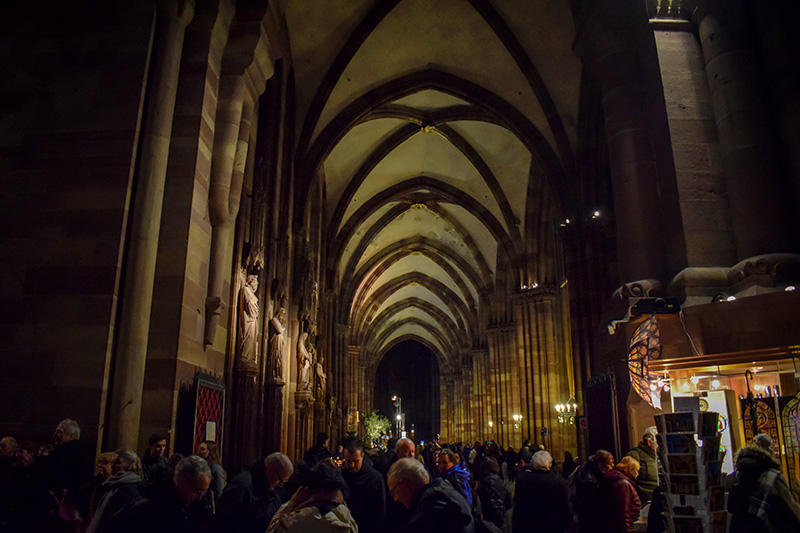
The south aisle where the Nativity scene is located © French Moments
A few anecdots!
Strasbourg Cathedral placed the Infant Jesus in the Nativity scene at the beginning of Advent so visitors could contemplate him. This was particularly the case during my visits in 2012 and 2018. It is customary for the figurine to be placed in the manger on Christmas Eve. For some years now, the Bible (or a liturgical book?) has occupied the place where the Baby Jesus will be placed on 25 December.
Joseph's physical transformation in the Nativity is a mystery! Look at the Nativity scene, where Jesus' adoptive father appears young and vigorous (with lots of hair on his head!). Now for the last scene, the Presentation in the Temple. Mary has not changed, but Joseph appears much older (and with much less hair on his head!).
Christmas in Strasbourg Cathedral
During your visit, be sure to admire the cathedral's stained glass windows, the choir and the following sites:
The 14th century Christmas window
The monumental Christmas Nativity scene is not the only representation of the Nativity in the cathedral.
Still in the south aisle, head east towards the pillar of angels. Then look up at the low glass roof.
![Stained-Glass Window South Aisle Strasbourg © Tilman2007 - licence [CC BY-SA 4.0] from Wikimedia Commons Vitrail Strasbourg © Tilman2007 - licence [CC BY-SA 4.0] from Wikimedia Commons](https://frenchmoments.eu/wp-content/uploads/2023/12/Stained-Glass-Window-South-Aisle-Strasbourg-©-Tilman2007-licence-CC-BY-SA-4.0-from-Wikimedia-Commons.jpg)
The stained glass window of the life of the Virgin and the childhood of Jesus (c. 1328) © Tilman2007 - licence [CC BY-SA 4.0] from Wikimedia Commons
Dating from around 1328, it depicts 16 scenes from the life of the Virgin Mary and the childhood of Christ.
![Strasbourg Vie de la Vierge et Enfance du Christ © Morio60 - licence [CC BY-SA 2.0] from Wikimedia Commons Strasbourg - Vitrail de la Vie de la Vierge et Enfance du Christ © Morio60 - licence [CC BY-SA 2.0] from Wikimedia Commons](https://frenchmoments.eu/wp-content/uploads/2023/12/Strasbourg-Vie-de-la-Vierge-et-Enfance-du-Christ-©-Morio60-licence-CC-BY-SA-2.0-from-Wikimedia-Commons.jpg)
Strasbourg - window of the life of the Virgin and the childhood of Jesus © Morio60 - licence [CC BY-SA 2.0] from Wikimedia Commons
The following scenes are of particular interest as Christmas approaches:
9. The Annunciation.
10. The Nativity
11. The Annunciation to the Shepherds.
12. The Adoration of the Magi.
13. The Presentation of Jesus in the Temple.
14. The Massacre of the Innocents.
15. The Flight into Egypt.
It is interesting to note that Mary's visit to her cousin Elizabeth was overlooked as an insignificant event by the glassmakers.
The Annunciation
![Strasbourg Vie de la Vierge et Enfance du Christ 06 © Morio60 - licence [CC BY-SA 2.0] from Wikimedia Commons Strasbourg - Vitrail de la Vie de la Vierge et Enfance du Christ © Morio60 - licence [CC BY-SA 2.0] from Wikimedia Commons](https://frenchmoments.eu/wp-content/uploads/2023/12/Strasbourg-Vie-de-la-Vierge-et-Enfance-du-Christ-06-©-Morio60-licence-CC-BY-SA-2.0-from-Wikimedia-Commons.jpg)
The Annuncation © Morio60 - licence [CC BY-SA 2.0] from Wikimedia Commons
The Angel Gabriel and the Virgin Mary are facing each other. Between them stands a vase from which a vigorous lily is emerging. The angel holds a phylactery and the Virgin a book. At either end are the prophets who, by waving their index fingers, seem to be pressing for the fulfilment of the prophecy.
The Nativity
![Strasbourg Vie de la Vierge et Enfance du Christ 03 © Morio60 - licence [CC BY-SA 2.0] from Wikimedia Commons Strasbourg - Vitrail de la Vie de la Vierge et Enfance du Christ © Morio60 - licence [CC BY-SA 2.0] from Wikimedia Commons](https://frenchmoments.eu/wp-content/uploads/2023/12/Strasbourg-Vie-de-la-Vierge-et-Enfance-du-Christ-03-©-Morio60-licence-CC-BY-SA-2.0-from-Wikimedia-Commons.jpg)
The Nativity © Morio60 - licence [CC BY-SA 2.0] from Wikimedia Commons
The stained glass window shows the Virgin giving birth, lying on the bed and leaning on her elbow. Behind the bed, we see the donkey and the ox feeding at the manger. On the right, Joseph contemplates the scene, leaning on his staff.
The Announcement to the shepherds
![Strasbourg Vie de la Vierge et Enfance du Christ 04 © Morio60 - licence [CC BY-SA 2.0] from Wikimedia Commons Strasbourg - Vitrail de la Vie de la Vierge et Enfance du Christ © Morio60 - licence [CC BY-SA 2.0] from Wikimedia Commons](https://frenchmoments.eu/wp-content/uploads/2023/12/Strasbourg-Vie-de-la-Vierge-et-Enfance-du-Christ-04-©-Morio60-licence-CC-BY-SA-2.0-from-Wikimedia-Commons.jpg)
The Announcement to the shepherds © Morio60 - licence [CC BY-SA 2.0] from Wikimedia Commons
Three angels announce the good news of the birth of Jesus to the shepherds grazing their sheep. The angels are revealed halfway up the clouds under the three-lobed arches.
The Adoration of the Magi
![Strasbourg Vie de la Vierge et Enfance du Christ 05 © Morio60 - licence [CC BY-SA 2.0] from Wikimedia Commons Strasbourg - Vitrail de la Vie de la Vierge et Enfance du Christ © Morio60 - licence [CC BY-SA 2.0] from Wikimedia Commons](https://frenchmoments.eu/wp-content/uploads/2023/12/Strasbourg-Vie-de-la-Vierge-et-Enfance-du-Christ-05-©-Morio60-licence-CC-BY-SA-2.0-from-Wikimedia-Commons.jpg)
The Adoration of the Magi © Morio60 - licence [CC BY-SA 2.0] from Wikimedia Commons
The window shows the Virgin Mary holding Jesus, who is reaching for the cup offered by one of the kneeling Magi. The famous star of Bethlehem can be seen guiding the Magi to Jesus.
The Presentation of Jesus in the Temple
![Strasbourg Vie de la Vierge et Enfance du Christ 07 © Morio60 - licence [CC BY-SA 2.0] from Wikimedia Commons Strasbourg - Vitrail de la Vie de la Vierge et Enfance du Christ © Morio60 - licence [CC BY-SA 2.0] from Wikimedia Commons](https://frenchmoments.eu/wp-content/uploads/2023/12/Strasbourg-Vie-de-la-Vierge-et-Enfance-du-Christ-07-©-Morio60-licence-CC-BY-SA-2.0-from-Wikimedia-Commons.jpg)
The Presentation of Jesus in the Temple © Morio60 - licence [CC BY-SA 2.0] from Wikimedia Commons
You can see the Virgin presenting Jesus to the high priest in the Temple.
The Massacre of the Innocents
![Strasbourg Vie de la Vierge et Enfance du Christ 08 © Morio60 - licence [CC BY-SA 2.0] from Wikimedia Commons Strasbourg - Vitrail de la Vie de la Vierge et Enfance du Christ © Morio60 - licence [CC BY-SA 2.0] from Wikimedia Commons](https://frenchmoments.eu/wp-content/uploads/2023/12/Strasbourg-Vie-de-la-Vierge-et-Enfance-du-Christ-08-©-Morio60-licence-CC-BY-SA-2.0-from-Wikimedia-Commons.jpg)
The Massacre of the Innocents © Morio60 - licence [CC BY-SA 2.0] from Wikimedia Commons
Here is the most tragic scene of the Nativity. Herod, seated on his throne, orders two soldiers to murder two children in the presence of their mother.
The Flight into Egypt
![Strasbourg Vie de la Vierge et Enfance du Christ 09 © Morio60 - licence [CC BY-SA 2.0] from Wikimedia Commons Strasbourg - Vitrail de la Vie de la Vierge et Enfance du Christ © Morio60 - licence [CC BY-SA 2.0] from Wikimedia Commons](https://frenchmoments.eu/wp-content/uploads/2023/12/Strasbourg-Vie-de-la-Vierge-et-Enfance-du-Christ-09-©-Morio60-licence-CC-BY-SA-2.0-from-Wikimedia-Commons.jpg)
The Flight into Egypt © Morio60 - licence [CC BY-SA 2.0] from Wikimedia Commons
The last window in the series shows Joseph leading the donkey carrying the Virgin and Jesus.
► Learn more about the stained-glass window of le vitrail de la Vierge et de l'enfance du Christ.
The tapestries of Strasbourg Cathedral
Another must-see in the cathedral during Advent is the 17th-century tapestries hanging in the nave.
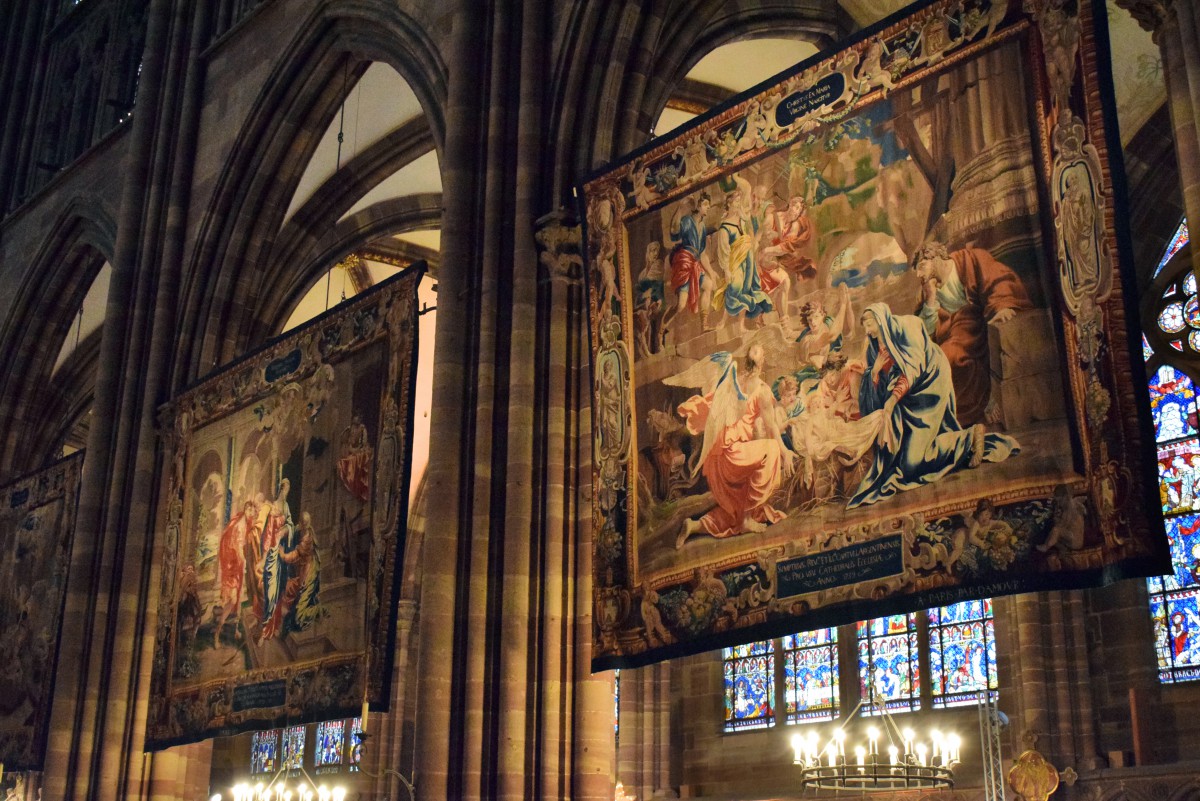
Strasbourg cathedral tapestries on display for Christmas © French Moments
This marvellous collection of fourteen tapestries adorns the nave of Strasbourg's Notre-Dame cathedral during Advent.
It is known as "Scenes from the Life of the Virgin" because each tapestry depicts a particular episode in the life of the Virgin Mary.
Tapestries at the origin of a royal vow
The origin of these tapestries dates back to Louis XIII's vow to consecrate the kingdom of France to the Virgin Mary in the event of the birth of an heir (which was long overdue!).
(It is interesting to note that, at the time, Strasbourg was a free city of the Empire and did not belong to France).
To make his wish come true, the king promised to give Notre-Dame cathedral in Paris a new high altar with an altarpiece, entrusting its execution to Philippe de Champaigne.
In response, Cardinal de Richelieu planned to contribute four tapestries on the Life of the Virgin theme for the Paris cathedral. The first two tapestries were designed by Philippe de Champaigne and woven by an unidentified Parisian weaver in 1640, but Richelieu's death in 1642 seemed to end the project.
In 1649, Abbé Le Masle, who was in charge of the cathedral choir, asked the painter Jacques Stella to resume the project. Nevertheless, only one tapestry was delivered, executed by the Brussels-Brabant workshops.
Subsequently, Charles Poerson was approached by Le Masle, and instead of simply completing the initial programme, he received a commission for eleven tapestries produced between 1652 and 1657. These pieces were woven in the workshop of the Parisian weaver Pierre Damour at a rate of about one every six months.
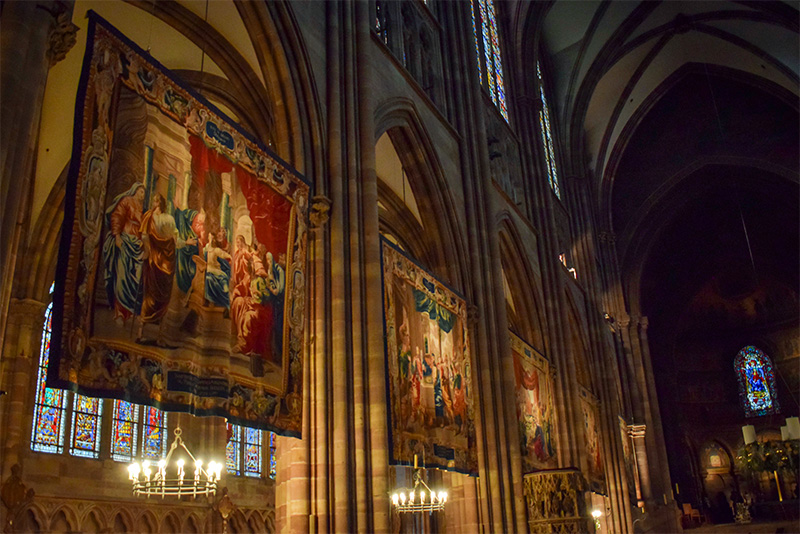
The tapestries in the nave of Notre-Dame de Strasbourg © French Moments
The tapestries move to Strasbourg
Despite these efforts, the tapestries quickly lost their usefulness when the choir was refurbished with a new painted décor, leading the chapter to seek to dispose of them from 1720 onwards.
Initially loaned to various Parisian churches, they were put up for sale in 1730, but no offer reached the sum requested.
Finally, in 1739, the bishop of Strasbourg, Armand de Rohan-Soubise, succeeded in acquiring them at the sale, probably using his connections, by offering ten thousand livres, well below the initial amount requested.
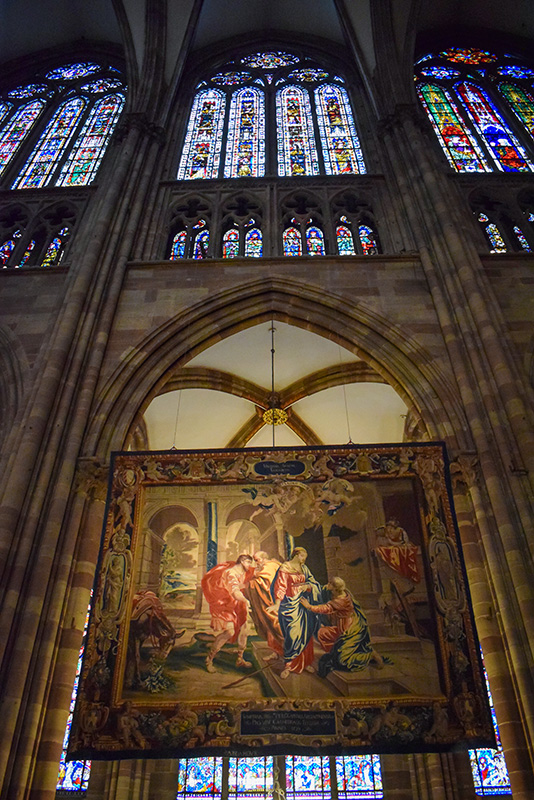
© French Moments
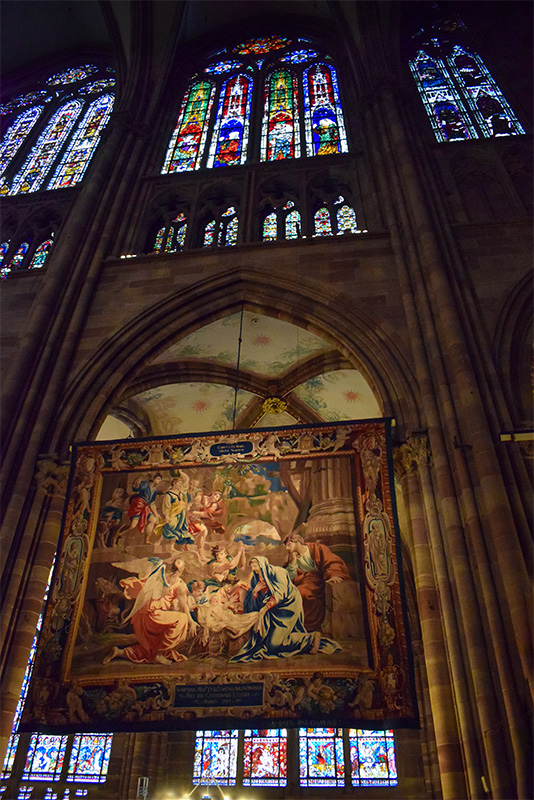
© French Moments
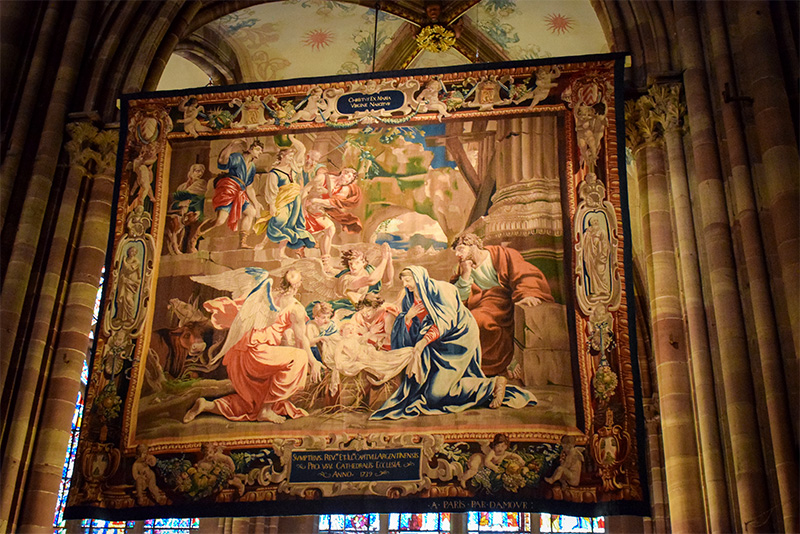
The Nativity scene © French Moments
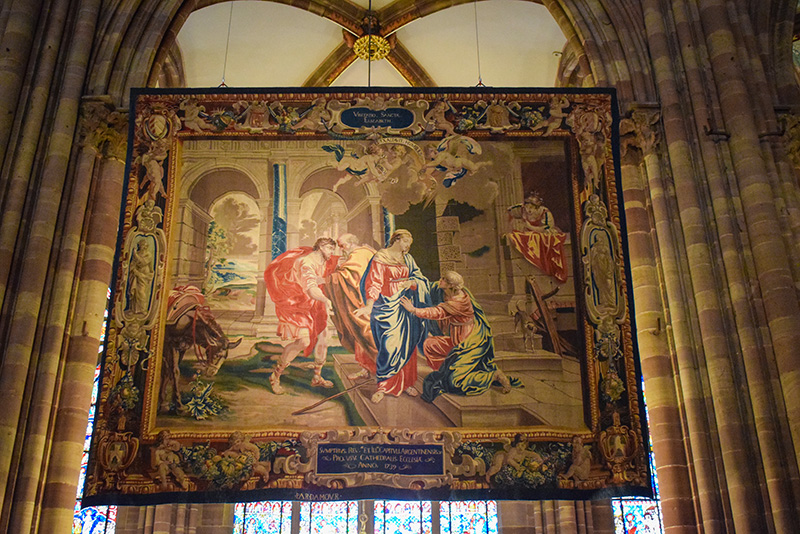
© French Moments
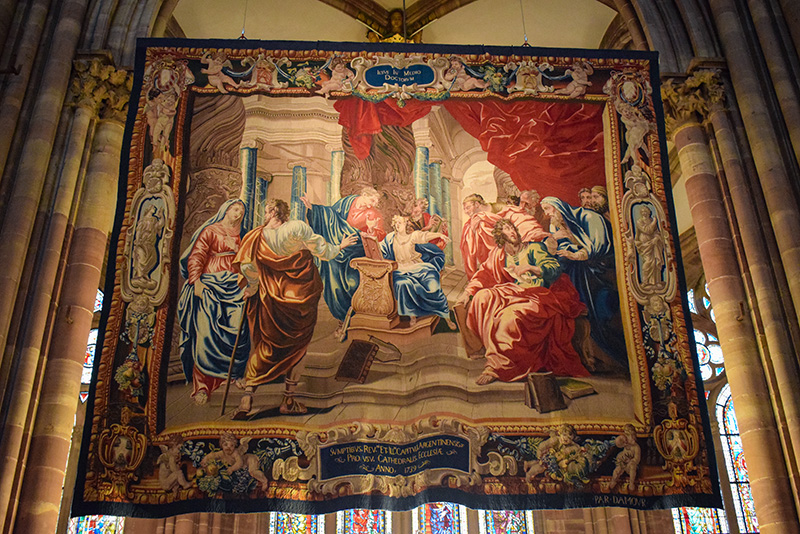
© French Moments
► Learn more about the 14 tapestries of Strasbourg Cathedral.
The giant Advent wreath
A monumental Nativity scene, a 14th-century stained glass Christmas window, sumptuous tapestries and... a giant Advent wreath!
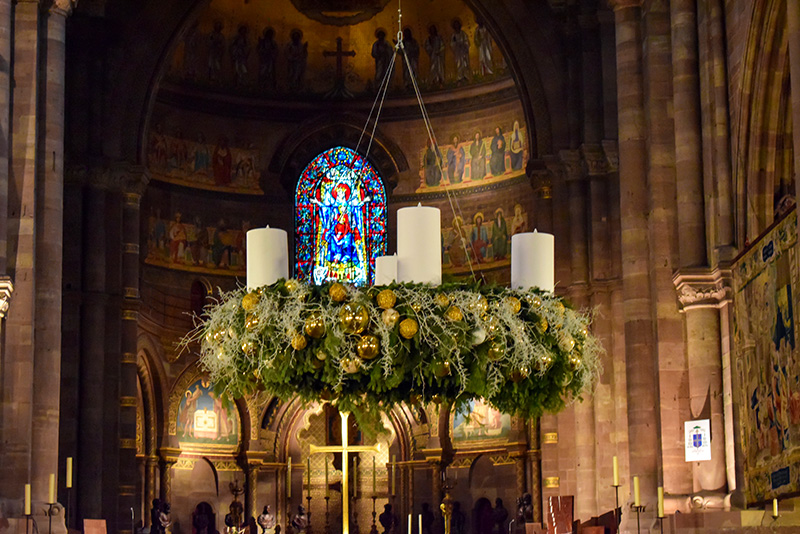
The Advent wreath at Strasbourg Cathedral © French Moments
The magnificent Advent wreath hanging in the nave is the work of florists from Strasbourg.
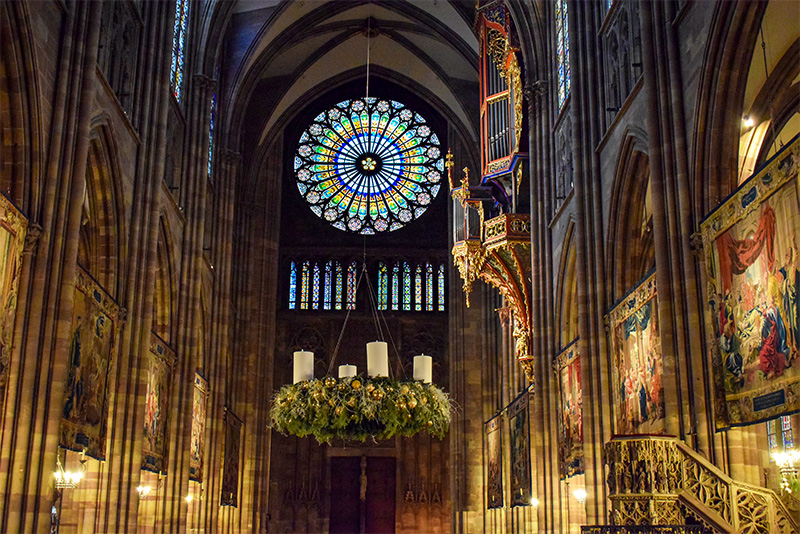
The nave of Strasbourg Cathedral © French Moments
The Astronomical Clock
The Astronomical Clock in Strasbourg Cathedral is famous for the way its automata play at precisely 12.30 pm. This Renaissance masterpiece houses a mechanism that dates back to 1842.

The Angel Pillar and Astronomical Clock in Strasbourg Cathedral © French Moments
The Angels Pillar
Not far from there stands a remarkable and unique column: the Pilier des Anges. This other Gothic masterpiece is the Pillar of the Angels. Dating from 1225, it depicts the four Evangelists (Matthew, Mark, Luke and John), four angels sounding the Last Judgement and, at the very top, the risen Jesus Christ, surrounded by three angels.
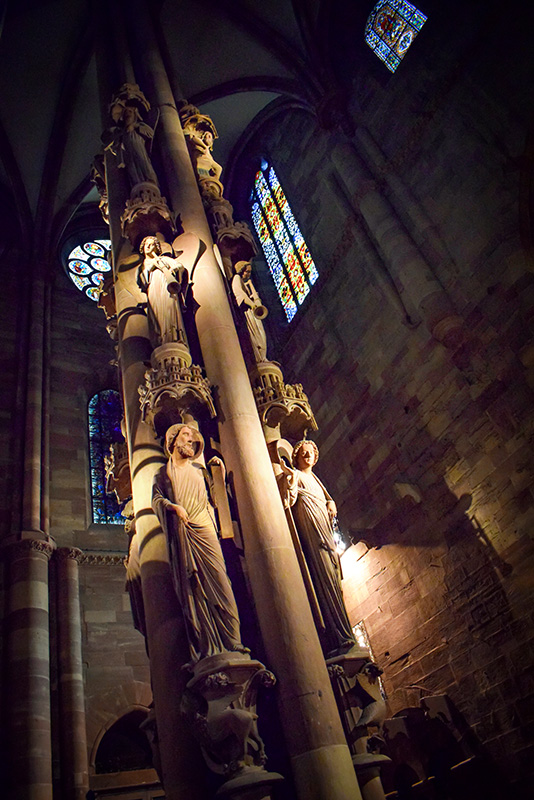
The 'pilier des Anges' © French Moments
The great organ and its Gothic case
As you make your way up the nave towards the exit, be sure to look up at the north side of the second bay. The great organ is there, hanging like a swallow's nest.

The great organ of Strasbourg Cathedral © French Moments
Its 15th-century polychrome sideboard is magnificent. It combines blue, green and red. The gilding completes the ensemble. The organ, by Alfred Kern, dates from 1981.
The large west rose window
Before leaving the cathedral, you must admire the cathedral's marvellous west rose window.
Stand at the transept crossing to admire it from the perspective of the nave, with its giant Advent wreath, 17th-century tapestries and organ case.
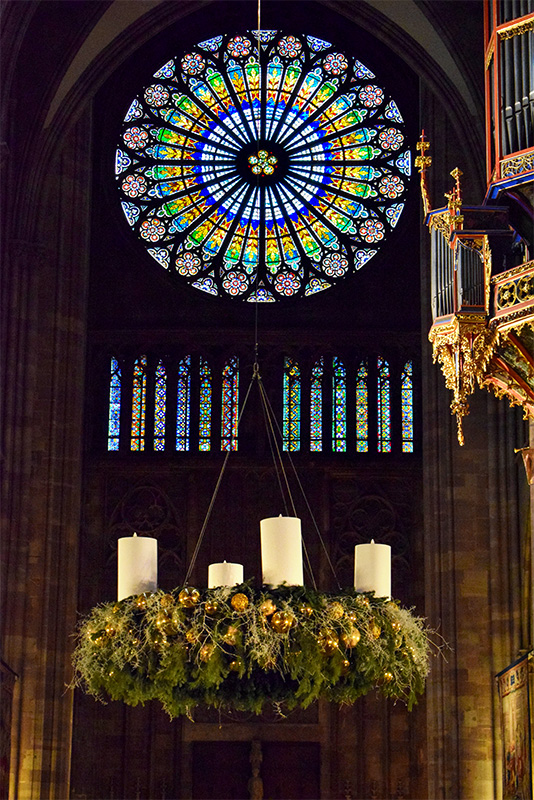
The west rose window and the Advent wreath © French Moments
The panoramic terrace
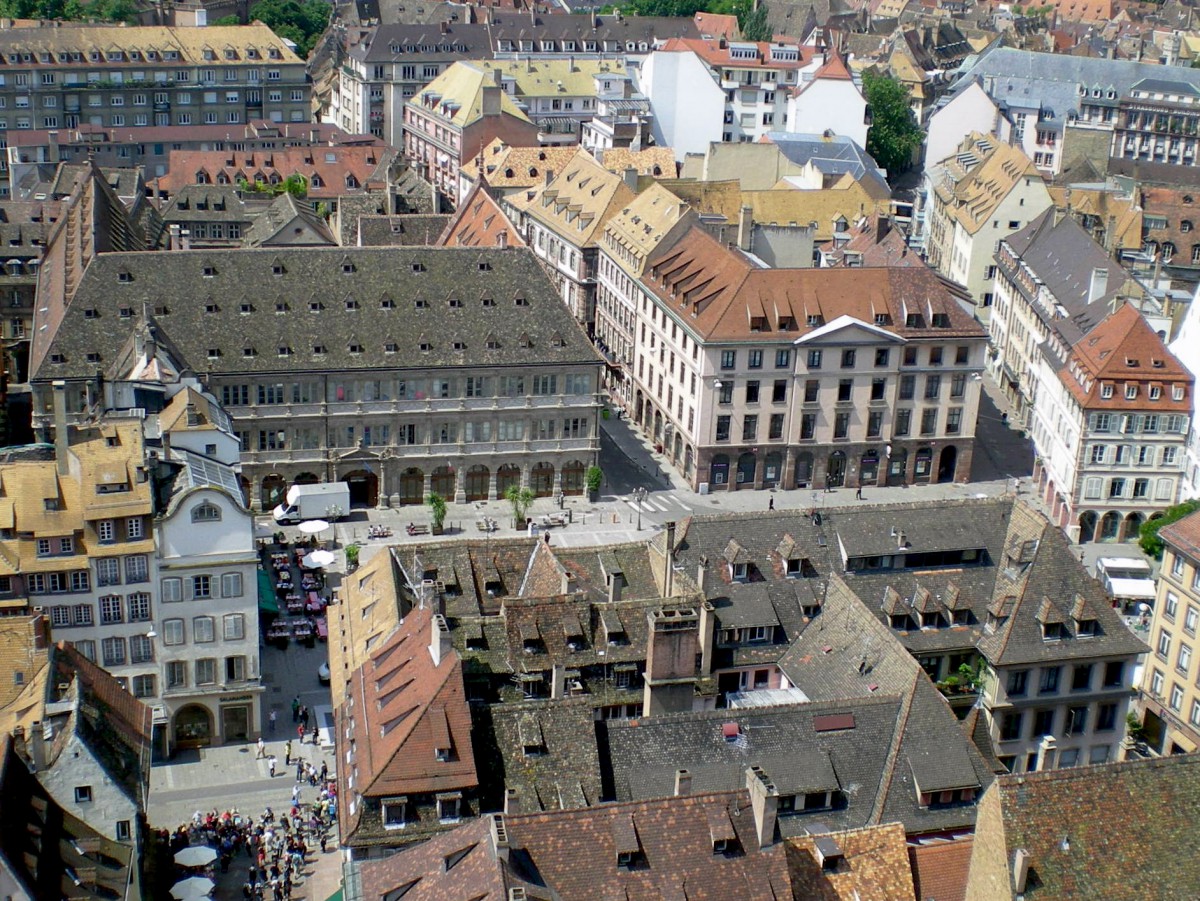
Place Gutenberg seen from the terrace of Strasbourg Cathedral © French Moments
After a visit to the interior, if your legs allow you, you can always climb the 332 steps leading to the panoramic platform of Strasbourg cathedral. More on our French blog…
Useful tips
You will find the Christmas cot in Strasbourg cathedral in the south aisle.
To enter the cathedral, go to the side door on the left (Maison Kammerzell side). Visits are not permitted during services (particularly on Sunday mornings).
Strasbourg's Notre-Dame cathedral is open to visitors Monday to Saturday from 9.30am to 11.15am and from 2pm to 6pm, and on Sundays from 2pm to 6pm.
Have you visited a church with a beautiful nativity scene? Tell us about it in the comments box below!

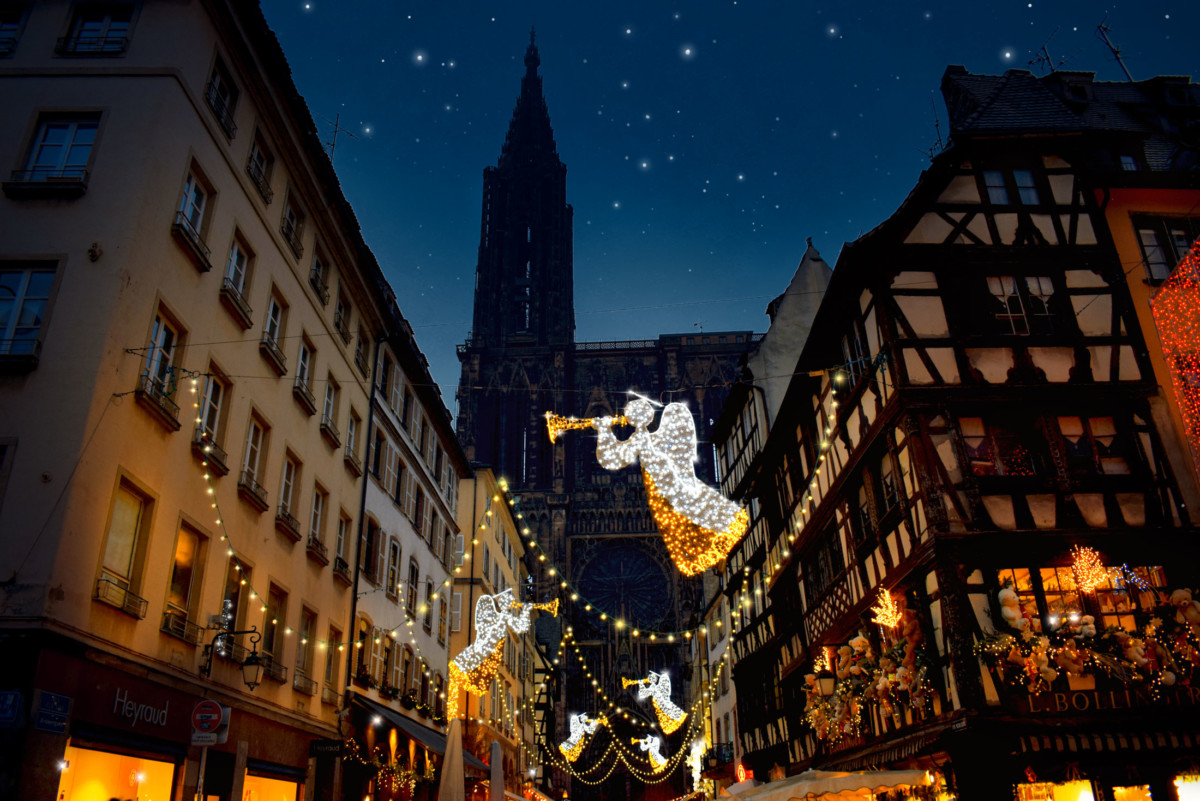

![Crèche Strasbourg 2021 © CathoAlsace - licence [CC BY-NC-SA 2.0 DEED] from Flickr Edition 2021 © CathoAlsace - licence [CC BY-NC-SA 2.0 DEED] from Flickr](https://frenchmoments.eu/wp-content/uploads/2023/12/Creche-Strasbourg-2021-©-CathoAlsace-licence-CC-BY-NC-SA-2.0-DEED-from-Flickr.jpg)
![Crèche 2021 © CathoAlsace - licence [CC BY-NC-SA 2.0 DEED] from Flickr Edition 2021 © CathoAlsace - licence [CC BY-NC-SA 2.0 DEED] from Flickr](https://frenchmoments.eu/wp-content/uploads/2023/12/Creche-2021-©-CathoAlsace-licence-CC-BY-NC-SA-2.0-DEED-from-Flickr.jpg)
![Strasbourg Vie de la Vierge et Enfance du Christ 02 © Morio60 - licence [CC BY-SA 2.0] from Wikimedia Commons Strasbourg - Vitrail de la Vie de la Vierge et Enfance du Christ © Morio60 - licence [CC BY-SA 2.0] from Wikimedia Commons](https://frenchmoments.eu/wp-content/uploads/2023/12/Strasbourg-Vie-de-la-Vierge-et-Enfance-du-Christ-02-©-Morio60-licence-CC-BY-SA-2.0-from-Wikimedia-Commons.jpg)
